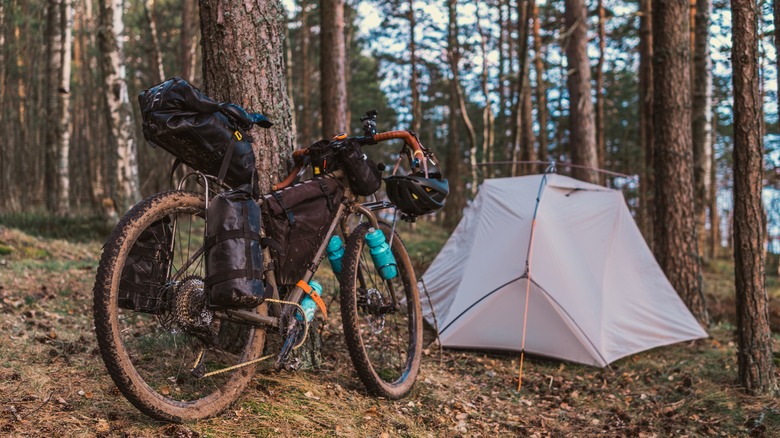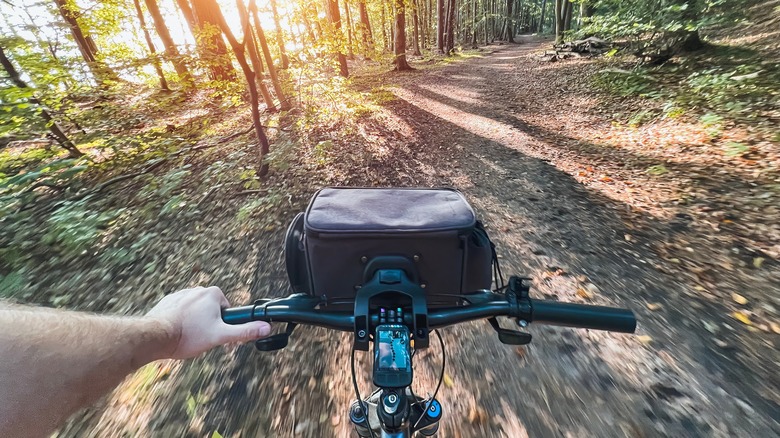The First Leg Of A New 'Pacific Crest Trail For Bikes' Has Opened In Washington
With each new season, another wave of hikers embarks on the Pacific Crest Trail (PCT), a 2,650-mile hiking route from Mexico to Canada. Venturing more than 500 miles on a single trip requires a permit, and only around 7,000 permits are issued each year. Still, countless others walk smaller segments of these interconnected paths, exploring the backcountry of Washington, Oregon, and California. The origins of the PCT date back to the 1930s, but the route surged in popularity after the publication of Cheryl Strayed's memoir "Wild" in 2012. Today, the PCT is considered one of the best backpacking locations in the world.
But many have wondered: What if you could take this same route by bicycle? For adventurers who prefer pedals and wheels over boots and poles, this route would seem ideal for mountain bikes. Given some thick tires and decent suspension, cyclists could turn these paths into fantastic single-track. They could move through the Cascades, Sierra Nevadas, and other Pacific ranges much faster, while still having ample time to admire the epic views and interact with fellow travelers.
This is the concept created by the Orogenesis Collective, a group that is dedicated to creating and managing long-range bike trails in North America. The brand-new trail system has just broken ground in Washington State. When complete, organizers hope to connect 5,029 miles of bike-ready paths, starting in British Columbia and ending in Baja California, Mexico (and vice versa). Not only is the Orogenesis route expected to wind its way through seven states, but it will also incorporate at least 50 Indigenous territories. The total elevation gain will be 471,000 feet, the equivalent of riding from the ocean to the top of Mt. Everest a total of 16 times.
A trail for the backpacking craze
This new trail by the Orogenesis Collective will cater specifically to "bikepacking," a relatively new genre of outdoor adventure. While bicycle-touring is as old as two-wheeled travel, bikepacking is (literally) geared toward mountain bikers who love to camp and travel as light as possible. An entire industry has grown around bikepacking in the past couple of decades, with specialized equipment, tent-friendly new routes, and a growing population of fans. Some cyclists like both, but most will decide what kind of two-wheeled tourist they are.
A challenge for bikepackers is figuring out where to go. Most are drawn to gravel roads and rustic trails, but it's hard to find a route that's long, open to cyclists, and actually goes somewhere. The Pacific Crest Trail (PCT) does not allow bicycles of any kind, and many stretches are technically wilderness because the Wilderness Act of 1964 explicitly forbids these vehicles from entering. Meanwhile, parts of the PCT are too steep or dangerous for cyclists, even on the sturdiest mountain bike.
That's why the Orogenesis trail is such a game-changer: This route would cover much of the same landscape, while also providing a safe and coherent space for bikepackers. When completed, Orogenesis is expected to be the longest mountain biking route on Earth. Increased traffic should also contribute to small-town economies, as bikers look for places to shower, resupply, and maybe grab some celebratory IPAs.
Timeframe for the Orogenesis trail
There's a long way to go, of course. The first section, known as the Loowit Tier, opened in Washington's Gifford Pinchot National Forest in May 2025. The 197-mile segment is nothing to sneeze at, and bikepackers can now ride from just south of Mt. Rainier up to close to the Washington-Oregon border without leaving the trail. What's doubly exciting for ambitious cyclists is that the Orogenesis trail will overlap with the Baja Divide, a 1,730-mile trail that already makes its way down the Baja Peninsula. In short, even after you've pedaled the entire length of the Pacific United States, a whole new expedition will await beyond the Mexican border.
At the moment, no one has any idea how long the Orogenesis trail will take to complete, and it's easy to imagine such a project taking decades. But as each stage is finished, bikepackers will have fresh new trails to explore in the coming years, as the Orogenesis Collective inches toward its continuous, 5,000-mile goal. While you're waiting, consider a bikepacking journey along North America's longest and arguably most scenic bike trail, right in the middle of the continent.


